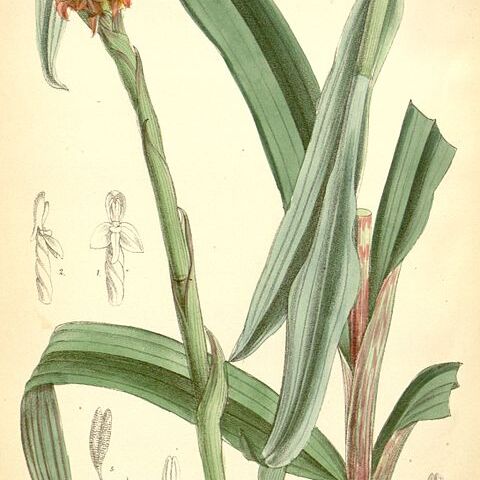Terrestrial herb, fairly robust, geophyte, 0.15-0.70 m high; with root tubers; sterile shoot rare. Leaves of fertile shoot 6-25, up to 80 mm long, cauline, grading into floral bracts. Inflorescence a very dense, cylindrical, tapering spike, 30-170 mm long; flowers 30-80, red. Sepals subequal; median sepal erect, galeate, spurred; spur pendent, 1.5-4.5 mm long, slender to club-shaped; lateral sepals 6-7 mm long, porrect. Petals narrowly obovate, acute. Lip 6 mm long, pendent. Flowering time Oct.-Feb.
Fertile shoots 15–70 cm long; cauline leaves imbricate, few if sterile shoots are present, numerous if not, largest at the base of the shoot, to 25 cm long, linear to narrowly lanceolate, acute.
Terrestrial herb, up to 0.7 m high. Inflorescence cylindrical, somewhat tapering, 30-170 mm long with numerous flowers. Spur (1.5-) 3.3-4.5 mm long. Petals narrowly obovate, acute. Flowers red.
Slender or robust, tuberous geophyte to 70 cm. Leaves cauline, few, linear to lorate. Flowers many in a dense raceme, red, spur pendent, lateral sepals 6-7 mm long, anther erect.
Spur pendent from just above the base of the galea, reaching to below the base of the galea, 1.5–3.3–4.5 mm long, cylindrical.
Dorsal sepal forming an erect galea, 5–7 mm long, 3–4 mm wide and c. 1 mm deep, elliptic to subobovate, obtuse.
Floral bracts narrowly ovate, acute to subacuminate, as tall as the flowers with the apices reflexed.
Terrestrial herb with separate fertile and sterile shoots, perennating by testicular tubers.
Sterile shoots rare, produce 3–4 semi-erect leaves c. 25 cm long, linear to lorate, acute.
Inflorescence dense, 3–17 cm long, cylindrical, 80–100-flowered.
Lateral sepals 6–7 mm long, narrowly oblong, acute.
Lip c. 6 mm long, lorate to linear, rounded.
Petals 4–6 mm long, narrowly obovate, acute.
Stigma with well developed lateral lobes.
Flowers brick-red, rarely orange.
Anther erect, c. 3.5 mm long.
Ovary 5–10 mm long.
Rostellum simple.

